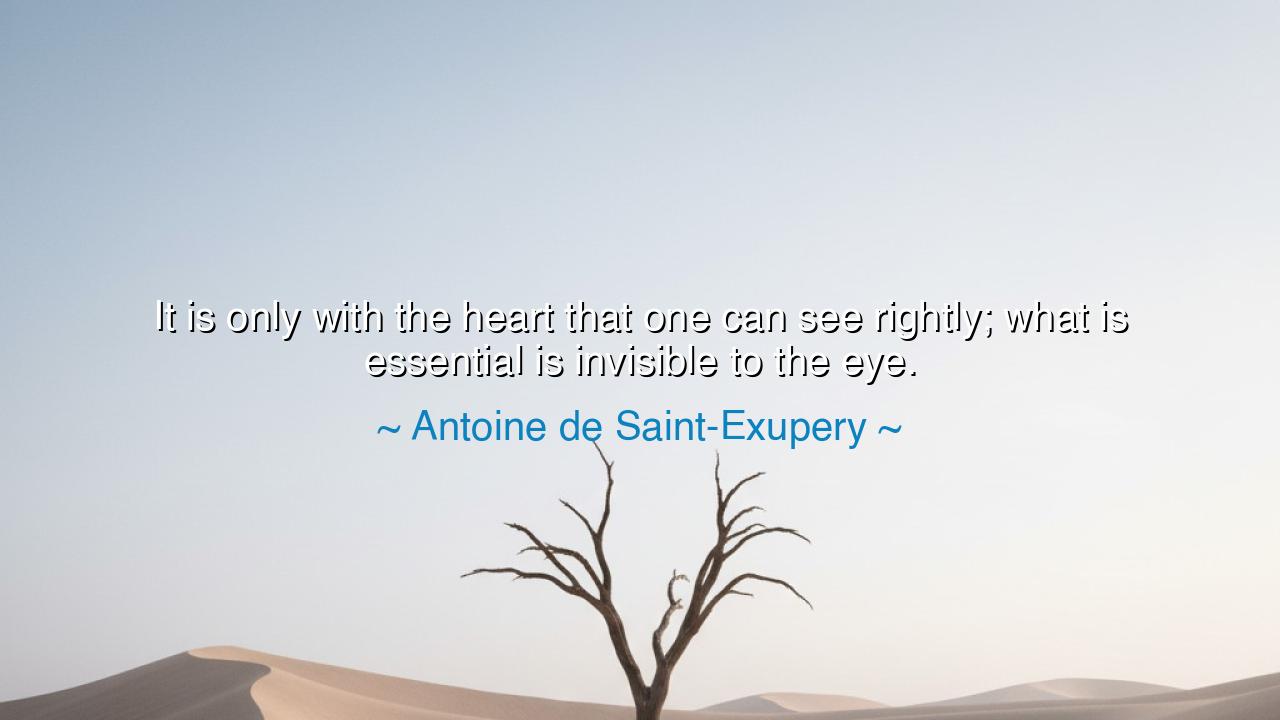
It is only with the heart that one can see rightly; what is
It is only with the heart that one can see rightly; what is essential is invisible to the eye.






Hear the eternal wisdom of Antoine de Saint-Exupéry, aviator and poet of the skies, who declared in his timeless tale The Little Prince: “It is only with the heart that one can see rightly; what is essential is invisible to the eye.” In these words he pierces the veil of appearances, reminding us that true vision is not of the flesh, but of the spirit. For the eyes see forms, colors, and surfaces, but the heart perceives essence, meaning, and truth. What is most vital—love, faith, friendship, hope—cannot be weighed or measured. They are unseen, yet they shape all of life.
The meaning of this teaching is that our deepest realities cannot be captured by appearances. Wealth may clothe a man, but it cannot reveal his soul. Beauty may dazzle the eye, but it may conceal emptiness within. Power may command obedience, yet leave the heart barren. The heart alone has the power to see what lies beneath—to discern the kindness of a friend, the loyalty of a companion, the innocence of a child. It is the heart that recognizes love, and in that recognition, knows what is essential.
The ancients bore witness to this truth. In Plato’s allegory of the cave, the prisoners mistake shadows for reality, seeing only with their eyes. But the philosopher, guided by the light of the soul, perceives the forms beyond illusion. So too does Saint-Exupéry remind us: the eye alone is deceived by shadows; the heart sees the real, though invisible. This wisdom has echoed through ages, for men forever risk confusing the glittering surface with the hidden essence.
History offers us examples as well. Consider the life of Mahatma Gandhi. To the eye, he was a frail man, simply clothed, unarmed, walking barefoot upon the earth. Many dismissed him as powerless. Yet those who looked with the heart saw his true essence—his unbreakable courage, his love of justice, his steadfast devotion to truth. And it was this invisible strength, unseen by the eyes of tyrants, that moved nations and shook empires. Thus, what was essential could not be measured by sight, but was revealed in the unseen power of spirit.
So too in the story of friendship and love. How often have men overlooked the humble, seeking the beautiful or the strong, only to find betrayal where they expected loyalty? Yet when one loves with the heart, one finds the invisible treasures—faithfulness, compassion, tenderness—that no eye could judge. The Little Prince himself learns this in his love for the rose: to the eye she is but one flower among thousands, but to his heart she is unique, for he has given her his care. Thus, the essence of love is invisible, yet more real than any form.
The lesson for us is clear: do not trust the eye alone, for it is easily deceived. Learn instead to look with the heart. Ask not only how things appear, but what lies within. Seek the invisible qualities—truth, love, goodness, and loyalty—for they are the foundation upon which life stands. The world exalts what glitters, but the wise honor what endures.
Practical is this path: when you meet another, do not judge by clothing, wealth, or beauty; search with the heart for kindness and sincerity. When you pursue goals, do not seek only what is seen—riches, status, applause—but what is essential: meaning, purpose, peace. And when you love, let it be not with the eye that desires, but with the heart that cherishes. For as Saint-Exupéry teaches, only with the heart can one see rightly; what is essential is invisible to the eye. And to live by this vision is to walk in truth, beyond shadows, into the eternal light.






TKBui Thieu Kien
The idea of seeing with the heart feels so powerful, yet it raises questions about how we perceive the world. If what is essential is invisible, does that mean that true understanding requires an emotional or spiritual connection, rather than just rational thought? How do we learn to trust our hearts to see what truly matters, especially when the world often encourages us to focus on the tangible and visible?
NHNguyen Hong
I love how this quote challenges the notion that sight is the most important sense. It suggests that understanding, love, and connection are found through the heart, not through what is immediately visible. But does this mean that everything invisible holds more value than what we can see? Are there things that are better left unseen or misunderstood in order to preserve our emotional well-being?
TDNguyen Tr duc
Saint-Exupery’s words feel like a reminder to look beyond the obvious and seek the deeper truths hidden within everything. It makes me wonder, though—can we always trust our hearts to guide us, or are there times when what is invisible is better left unseen? How do we strike a balance between seeing with our hearts and not ignoring the practical aspects of life?
HNPham Thi Hong Ngoc
This quote really makes me think about how much we often overlook the most important things in life. We’re so caught up in the surface level, the visible, that we forget to look deeper into the heart of things. But what happens when we start to prioritize our emotions and intuition over what we can see? Does it mean we’re ignoring reality, or are we simply perceiving it more fully?